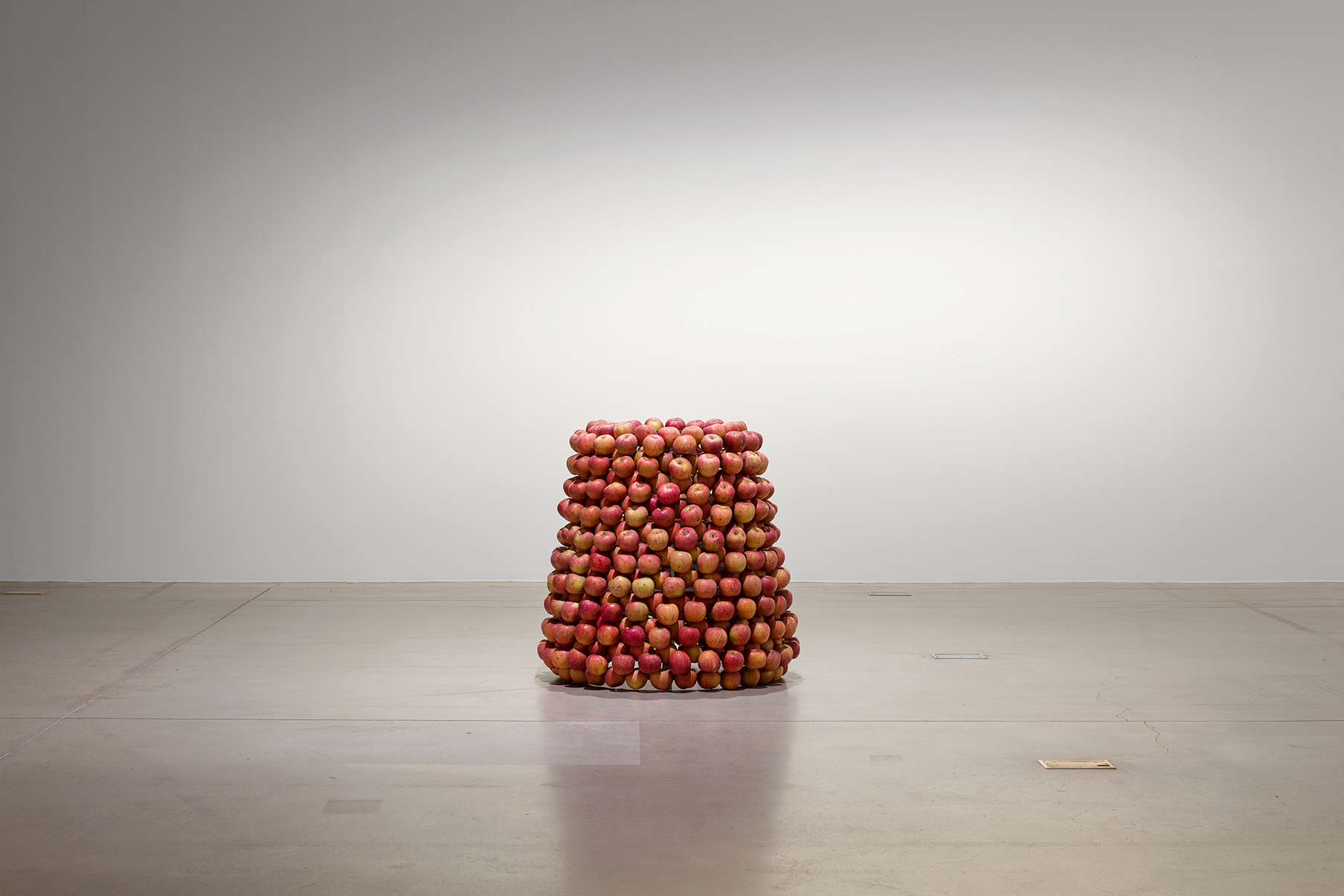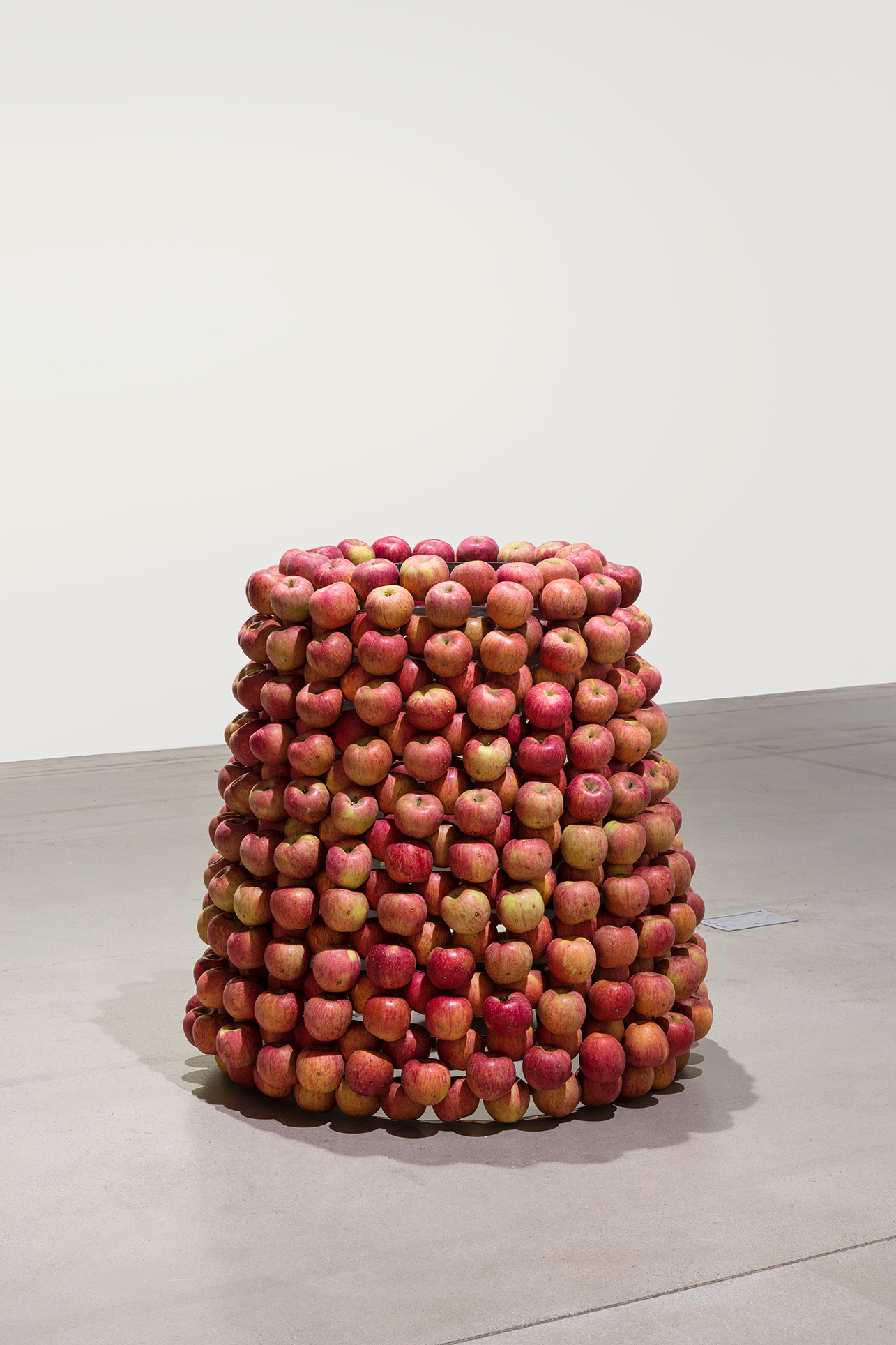Human Order (Apple Tower)
2019
stainless steel, apples
dimensions variable
size of stainless steel:95x95x(H)110cm
︎︎︎The Politics of Material
Material — along with form, size and color — is a central element of an artwork. However, material can be the most politically charged among all of these elements. For example, if we explain by using the metaphor of a person, whether one is good-looking or not, tall or short, or dark- or light-skinned would be considered irreversible, natural conditions. On the other hand, clothing and the way one dresses would be considered a choice. Therefore, “to dress” is a human and political act. For artists, architects, fashion designers, and many others who create three-dimensional objects, their choice of material clearly reflects their political attitude. For example, to create an artwork from stone creates a vastly different outcome and context, than when those stones are replaced with concrete. Even for the same artwork, whether its material is Styrofoam or bronze reflects very different political overtones. Marble and brick are completely different materials, and when a piece of marble is painted in lacquer or a brick is covered in gold leaf, it disrupts our existing framework of perception. A tiger flaunting its shiny fur and a tiger covered in mud are fundamentally different from a tiger masquerading in leopard fur or zebra fur. If the former is a matter of the original, the latter is a matter of reproduction. If the former is about the politics of material, the latter is about the politics of appearance.
This work consists of apples, and because of the material, it can only maintain its original form for about twenty days. After twenty days, the apples need to be discarded as a whole or be replaced with fresh ones. By all standards, both options are not particularly appealing scenarios.
In this work, the material does not reflect its politics, but the artist’s attitude of utilizing the material is political. Moreover, staging such an unwanted dilemma and making its objective obscure demonstrates artistic politics. Such disruption of perception is perhaps one of the virtues of art, as the objective of art is to propose a new (or different) framework of perception by rupturing the social system and established concepts of the status quo.
︎︎︎재료의 정치성
미술작품에서 재료는 형태, 크기, 색과 함께 매우 중요한 구성 요소이다. 그러나 재료는 다른 요소보다 정치성을 강하게 띤다. 인간을 예로 들자면 외모가 잘 생기거나 못 생기거나, 키가 크거나 작거나, 피부가 검거나 흰 것이 인간이 스스로 선택할 수 없는 불가항력적 조건이라면 옷은 충분히 조정 가능하다. 그래서 ‘옷을 입는 것’은 인간적이고 정치적이다. 미술가, 건축가, 패션디자이너와 같이 입체적인 것을 제작하는 사람들에게 재료 선택은 그의 정치적 태도를 선명하게 드러내는 일이다. 예를 들어 돌을 미술 작품으로 만드는 일과 돌을 콘크리트 조각으로 대체하는 것은 내용면에서 매우 다른 결과를 초래한다. 똑같은 형태라도 재료가 스티로폼인 경우와 브론즈인 경우, 그 결과물은 전혀 다른 정치성을 띤다. 대리석 조각과 벽돌은 전혀 다르며, 대리석 위에 락커 칠하거나 벽돌을 금박으로 입히면 기존의 인식체계에 혼란을 주게 된다. 털에 윤기가 흐르는 호랑이와 흙물이 잔뜩 묻은 호랑이는 표범 무늬 옷을 입은 호랑이와 얼룩말 무늬 옷을 입은 호랑이와는 근본적으로 다르다. 전자는 원본의 문제라면 후자는 복제의 문제고, 전자가 재료의 정치라면 후자는 표면의 정치이다.사과로 이루어진 이 작품은 그 재료의 유한성 때문에 길어봐야 약 20일 정도까지 원래의 모습을 유지할 수 있다. 일반적으로 20일이 지나면 사과가 썩기 시작하기 때문에 모두 버리거나 아니면 새 사과로 교체해야 한다. 사과를 모두 버리던가, 새 사과로 교체하는 일을 바라본다는 것은 보편적 문명의 기준으로는 유쾌한 일은 아니다.
이 작품은 재료가 나타내는 정치성보다는 재료의 성질을 이용하는 미술가의 태도가 정치적이다. 덧붙여 유쾌하지 않은 상황을 연출하는 것이 어떤 목적인지 모호하게 하는 것도 미술적 정치성이다. 이러한 인식의 혼란은 미술의 덕목 중 하나이다. 미술은 동시대에 구축된 인식과 사회적 체계에 균열을 주어 새로운(혹은 다른) 인식의 구조를 제안하기 때문이다.

